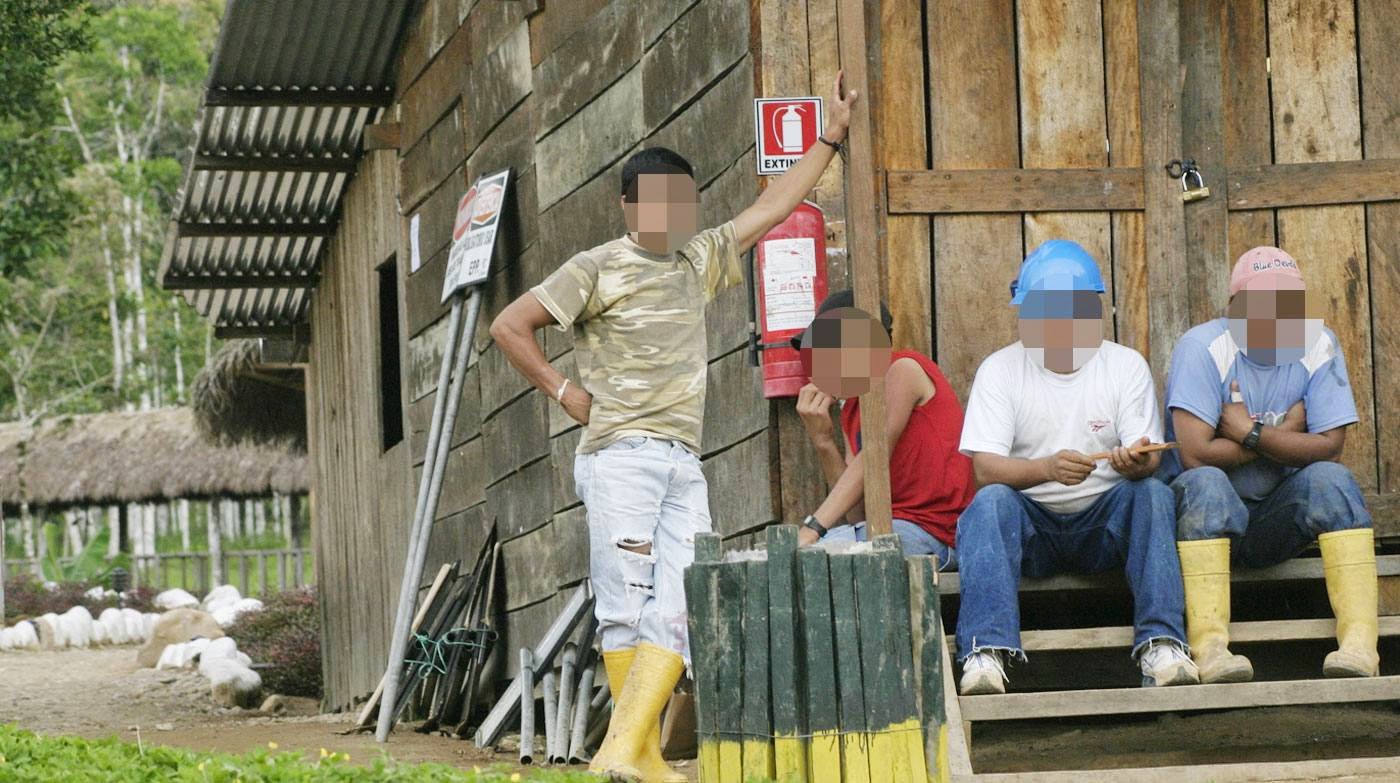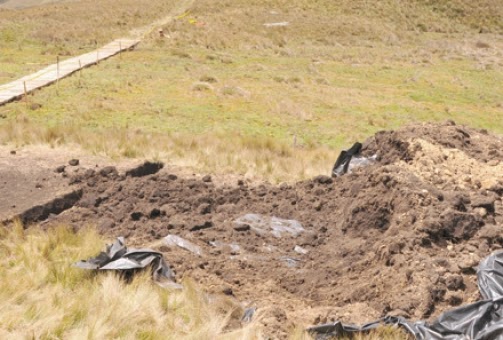![]()
Although the Ecuadorian government has vehemently insisted in recent months that it supports the communities affected by Chevron Texaco, which have been resisting for more than 20 years, the truth is that this same government is accused by the communities of employing the same or similar strategies as previous governments regarding extractivism in the country. In some cases it is understood that the government's final policy is to "kick in doors."
Below are 9 communities in Ecuador that maintain processes of resistance, which the Ecuadorian Government prefers you not to know about.
All these projects have strong environmental, social and economic impacts on the inhabitants.1. Llanchama, Yasuni National Park, Orellana Province.
 |
| ANDDeep in the Yasuní National Park, The Llanchama community denounces Petroamazonas' irregularities and rejects the exploitation of its territories |
This community has a long history of three years of resistance to the Petroamazonas company and its infiltration into the Park for oil extraction.
Known as Llanchama, Bastion of Resistance of Yasuní, the National Government in recent years has done everything from changing the indigenous system of community organization to establishing oil blocks in all the parks, except for the intangible zone, in order to be able to enter with the exploitation in this community that remains in resistance. For several months now, there have been complaints that the communitiesCommunities feel cheated by Petroamazonas.
In May 2014, the Ministry of Environment issued a permit to give the green light to crude oil extraction. The communities rejected this decree and demanded ownership titles to their ancestral lands.
For more information you can read the Public complaint made about irregularities in the oil sector
2. Intag, Imbabura Province
This community has been resisting for many years to prevent the total takeover of their community by mining interests.
Since copper and gold, Intag has resisted companies such as Mitsubishi, Ascednant Copper and 9 consecutive governments that have tried to enter this area. Among the effects on the community, there is persecution of indigenous leaders, aggression, threats, and imprisonment. Currently, the Government through the Ministry of Natural Resources is auctioning concessions in the Intag area and handing over the project to ENAMI EP for exploitation by a private company.
 |
| During the Intag resistance processes, Its inhabitants have had to confront even the paramilitaries of the mining company, as this image from 2006 demonstrates. |
The community is in resistance. As of May 16, 2014, more than 450 police officers have entered the community and surrounded the entrances. Tourists have been turned away and those who support the resistance of the Intag community are not allowed to enter. For more information click here
For ongoing information on the situation in Intag, please visit the blog of the Zonal Coordinator
3. Sarayaku, Pastaza Province
Sarayaku is the community that has been most successful in defending its territory.
The case of Sarayaku for granting an oil concession in its territory in the early 1990s without considering prior consultation, was carried out after the Inter-American Commission on Human Rights issued a background report in December 2009 concluding that Ecuador has violated, among others, Sarayaku's rights to life, integrity, property, and judicial guarantees.
The IACHR issued a series of recommendations to the Ecuadorian State, which were not complied with. Based on this, the IACHR decided to file a complaint before the Inter-American Court of Human Rights in April 2010, won in this international instance. The case summary in This link to the official Sarayaku website
Sarayaku recently made the decision to protect three Ecuadorian citizens who were considered by its Governing Council to be "politically persecuted" by Correa's government, who criticized this decision. Meanwhile, there were harassments and attacks against the residents who were branded by the government as paramilitaries. At the end of the period of said Council, the newly elected indicated in a press conference that these people were no longer in its territory.
4. Santa Isabel and Jubones, Azuay Province
On May 22, 2014, representatives of communities such as Santa Isabel, Jubones, and other cantons of Azuay, led a march in Defense of Water, the Environment and against mining exploitation; supporting the struggle of
In several towns, community members demonstrated against the persecution of leaders who defend their lands.
Agriculture is being threatened by mining concessions covering thousands of hectares.
To see the full note Please enter this link
5. Pangui, Zamora Chichipe Province
“A land conflict with the inhabitants of two parishes in the El Pangui canton, in Zamora, is presented as an obstacle to the progress of the Mirador mining project.”
As the current government has declared this large-scale mining project as one of the priority projects, the families are being pressured to sell their land at low and unfair prices.
 |
| Workers of the transnational mining company are accused by the company |
“The Mirador copper project is one of the five large-scale mining projects identified as strategic for the State. It is managed by the Chinese company Ecuacorriente (ECSA), which has a 25-year exploitation contract. It plans to invest around USD 2 billion.”
Mirador Project.
Chinese banks financing the project are accused of committing irregularities by not respecting the Green Credit Directive of their own government which requires measuring socio-environmental impacts and adhering to international standards and good practices that the company receiving these funds would not be complying with.
Meanwhile, in May 2014, while the company was demolishing a school and a church to advance the extractive project, it accused its own workers of taking over a company camp. Full note
6. Dureno (Cofán Nationality), Sucumbíos Province
One of the communities most affected by pollution and cultural destruction since the mid-1980s, this community has once again been the victim of the same forms of pressure to accept oil exploitation within its territories. The pressure and deception by the oil companies include offering food to the elderly, giving gifts on the very day of the prior consultation, etc. Currently, it is reported that there are sanctions for community members who express their rejection of this type of activity, by means of which they are excluded from the possible benefits that the community members may have.
To better understand the situation of the Cofán nationality, please watch the documentary Cofanes, resistance and worldview
7. Mompiche, Esmeraldas Province
One of the most renowned beaches for its natural beauty, is also facing resistance due to the insistence of mining companies. The Gran Nacional Minera Mariscal Sucre is in charge of drilling projects in the titaniferous ferrous sands of the project.
Video denouncing damage caused by mining in Playa Negra, Mompiche
.jpg) |
| Processes of life cycles of species protected like sea turtles are interrupted by mining activities in Mompiche |
DISCOMFORT among residents due to the extraction of black sand
FB Group: Save Mompiche Beach
8. San Pablo de Amali, Bolivar Province
The community of Saint Paul has been in 10 years of resistance to the hydroelectric project of the current government of Rafael Correa.
More than 74 communities would be affected by the construction carried out by Hidrotambo.
 |
| Despite attempts to convince the population with presidential visits, Community rejects hydroelectric project |
Residents of the area have had clashes with both police and military. There have been complaints from people claiming to be representatives of the Presidency of the Republic. There are, as in other communities in resistance, Several lawsuits against community defenders
But just as in other cases of community members from other areas of the country who have been accused of sabotage and terrorism, the opposite has been proven, which has raised successful resistance cases
9. Kimsacocha, Azuay Province
The Kimsacocha area is a wetland, the remains of an inactive volcano that with its exuberant volcanoes, rivers and lagoons, It is currently in the advanced exploration phase.
 |
| The Kimsacocha wetlands feed important rivers. |
The community's concern is due to the potential environmental damage of the Loma Larga mining project (under the direction of the Canadian company INV Metals) since this moorland is a highly sensitive area. The Kimsacocha wetlands feed the rivers that flow into the Paute and Jubones basins, which would be at risk of being contaminated.
The case of Engabao, Guayas Province
The community of Engabao has been resisting the abuse of Fabricio Correa (brother of Rafael Correa) in recent years.
In this sense,
 |
| Engabao is mostly a community of fishermen who begin to bet on tourism |
The community has been able to successfully demonstrate that these lands belong to them, but they are under constant threat and are in need of protection of their communal territory.
Until May 2014, community resistance continues under pressure from Fabricio Correa through his company, Campibo, who He was expelled from Engabao by the commoners months ago
INVESTIGATION:
Daniela Bermeo T.
YASUNI RESIST COLLECTIVE
To be aware of the conflicts that arise in communities due to their resistance to large-scale mining activities in their territories, Please visit this link


